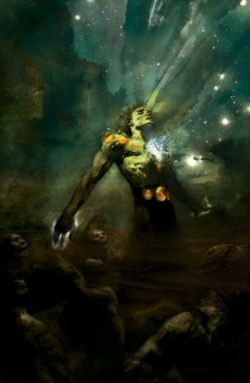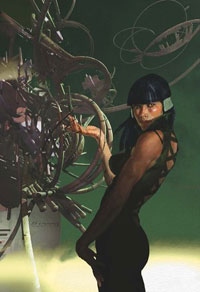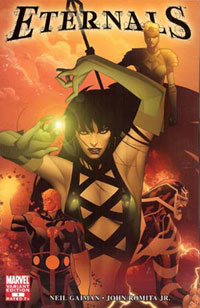

Marvel Comics
Eternals #1 - #7
By Al Kratina
March 25, 2007 - 11:22
Publisher(s): Marvel Comics
Writer(s): Neil Gaiman
Penciller(s): John Romita Jr
Inker(s): Danny Miki
Colourist(s): Matt Hollingsworth, Paul Mounts
Letterer(s): Todd Klein
Cover Artist(s): Rick Berry
Neil Gaiman has been away from comic books for entirely too long. Perhaps the jet-setting, mile-a-minute lifestyle of a fantasy novelist has had too much attraction for him in recent years, with its rivers of free cocaine and harems of blonde, empty-headed socialites. However, nostalgia seems to have drawn him back to his roots as an ink-stained wretch, toiling in obscurity, penning ream after ream of romantic comic book prose rife with lofty ambitions and grand themes of love, the nature of storytelling, and in the case of The Eternals, giant robots.
Well, not robots, precisely. But enormous cosmic beings that look like robots. More specifically, in the hands of artist John Romita Jr, they look like Iron Man, back when he wore a bucket instead of a helmet. They are, of course, the Celestials, beings as old as time, who are responsible for creating two Earth races spawned from proto-humanity. The Eternals, powerful immortals, and the Deviants, a shape-changing horde of evil, have been warring for eons, while awaiting the coming of the next Host of Eternals to judge the Earth. Created by Jack Kirby, the Celestials, Eternals, and Deviants have somewhat disappeared from the Marvel Universe of late, presumably to make room for another team of teenaged X-Men. But Gaiman has revived them, as well as giving an explanation of their absence. In the first few issues of this seven issue miniseries, we are introduced to several ordinary characters, who turn out not to be so ordinary after all. Mark Curry is an intern at a hospital. Sersi is a party planner from an alternate universe where promoters are apparently not all coked-up drug tramps, and Druig is a diplomat from one of those made up comic book countries like Latveria, Kahndaq, and Liechtenstein. What brings them together, however, is the fact that they are all Eternals who have had their memories rewritten by Sprite, a rogue Eternal. The only one who remembers their past is Ikaris, and under his guidance their powers slowly begin to manifest, and their memories return, just in time to battle an army of Deviants and try to prevent the awaking of a sleeping Celestial, whose rise from slumber may destroy the planet.
Gaiman's writing is playful, yet intellectual, as always. He toys with mind-bending concepts, suggesting a world of ideas beneath the surface of his story. And best of all, for someone whose literary influence stretch back to Chaucer and Shakespeare, his dialogue is remarkably humorous and naturalistic. Gaiman's Deviants, especially, speak colloquially without sounding like they've been re-written for a TV pilot on Fox. The story reveals itself gradually, with near-perfect pacing, moving from mystery to action smoothly. The only flaw comes with the final issue, which seems to be more of a full-length epilogue than a continuation of the story. Everything wraps itself up nicely by issue 6, but there's still an entire issue of loose ends that feels as if Gaiman's love of fantasy has caused him to fall too deeply in love with the 50 pages of Lord of The Rings where everyone walks home after Sauron is defeated. Still, that's a minor complaint in a series that's satisfying and complete.
John Romita Jr is another creator whose output has been somewhat limited of late. Perhaps that's not his choice. Perhaps readers have grown tired of characters that all look like lumberjacks sketched in charcoal. I, however, have not, and still find his work dynamic and original. In Eternals, Romita really gets to play around, particularly with the Deviants, who become truly horrifying in his hands, with their tentacles and schizophrenically random shapes. The painted covers, by Rick Berry, contrast nicely with the style of the interiors, but strangely both match the vaguely mystical yet modern feel of the writing. Whereas the covers give the impression of a smeared, hallucinogenic vision, Romita's pencils, as artful as they are, have a sketchy, amorphous feel, as if born of automatic writing, that's equally befitting of the mood created by Gaiman. It's no Sandman, to be sure, but it's a welcome return of a writer and an artist who have been absent from their medium for far too long.
© Copyright 2002-2021 by Toon Doctor Inc. - All rights Reserved. All other texts, images, characters and trademarks are copyright their respective owners. Use of material in this document (including reproduction, modification, distribution, electronic transmission or republication) without prior written permission is strictly prohibited.
|
|




